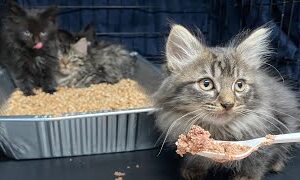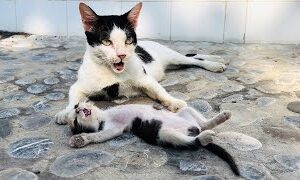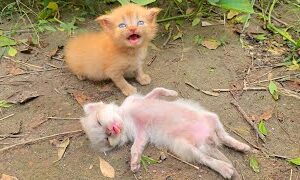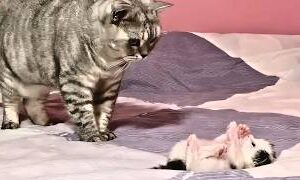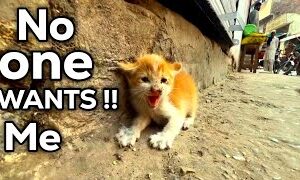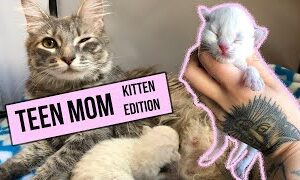It was a seemingly ordinary morning in the quiet suburban home of the Smith family. Sunlight streamed through the windows, casting a warm glow on the living room. Mr. and Mrs. Smith were sipping their coffee, engrossed in their morning newspapers, when a peculiar sound caught their attention.
From the kitchen, a strange, almost mournful wail echoed through the house. It was a sound they hadn’t heard before – a sound that seemed to come from their beloved ginger cat, Whiskers.
Mr. Smith, ever the curious one, put down his newspaper and headed towards the kitchen. What he saw there would forever change his understanding of feline behavior. Whiskers, usually a picture of feline tranquility, was sitting on the counter, his eyes wide with distress, and his tongue an unnatural shade of purple.
As Mr. Smith approached, Whiskers let out another mournful wail, his eyes welling up with tears. The sight was both heartbreaking and baffling. What could possibly be causing such distress in their normally cheerful cat?
Mrs. Smith, alerted by the commotion, rushed into the kitchen. She immediately noticed the unusual color of Whiskers’s tongue. “What on earth happened to his tongue?” she exclaimed, her voice filled with concern.
Mr. Smith, equally perplexed, suggested that Whiskers might have ingested something poisonous. They quickly searched the kitchen, checking under appliances and behind cabinets, but found nothing suspicious.
With growing worry, they decided to take Whiskers to the veterinarian. The vet examined the cat thoroughly, but found no signs of poisoning or any other medical condition. The only abnormality was the peculiar color of his tongue.
The vet, baffled by the situation, suggested that it might be a rare case of food coloring or some other substance that Whiskers had licked. However, Mr. and Mrs. Smith were certain that there was nothing in their home that could have caused such a bizarre reaction.
As days turned into weeks, Whiskers’s tongue remained purple. The strange incident became a source of fascination and amusement for the neighborhood. People would come over to see the “purple-tongued cat,” marveling at the unusual sight.
Despite the oddity of his condition, Whiskers remained his cheerful self. He continued to play with his toys, chase after butterflies, and demand attention from his human companions. The purple tongue, though a constant reminder of the mysterious incident, did not seem to bother him in the least.
As time went on, the purple color gradually faded, leaving behind a faint tinge that was barely noticeable. The incident, though perplexing, became a cherished memory for the Smith family, a reminder of the day their cat cried purple and brought a touch of magic to their ordinary lives.
The story of the purple-tongued cat spread far and wide, becoming a local legend. It was a tale that sparked curiosity, sparked imagination, and reminded people that even the most mundane of lives can be touched by the extraordinary.
And so, Whiskers, the once-purple-tongued cat, continues to live a happy and fulfilling life, a testament to the resilience of the feline spirit and the enduring power of mystery.

